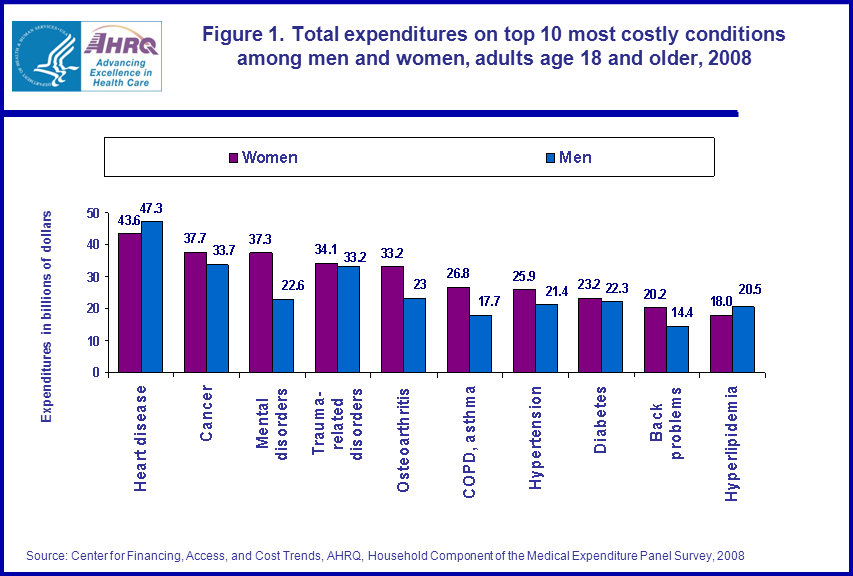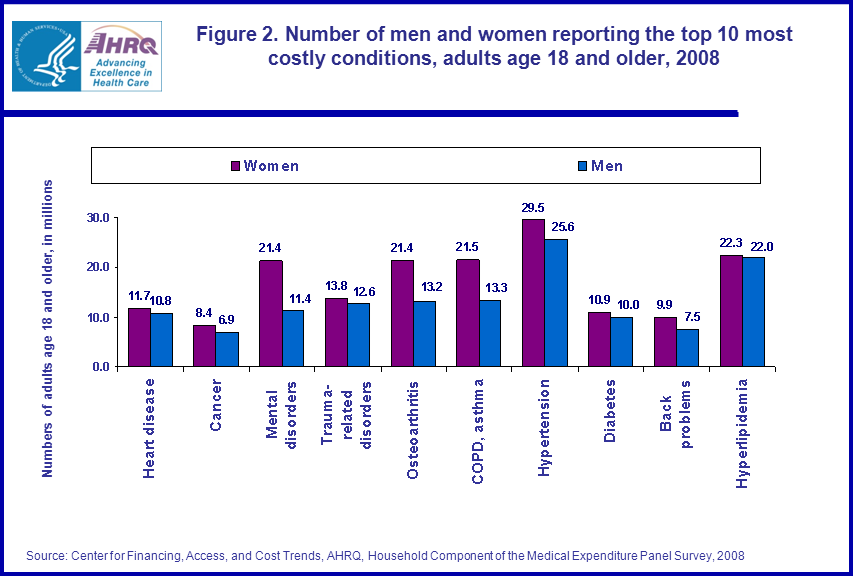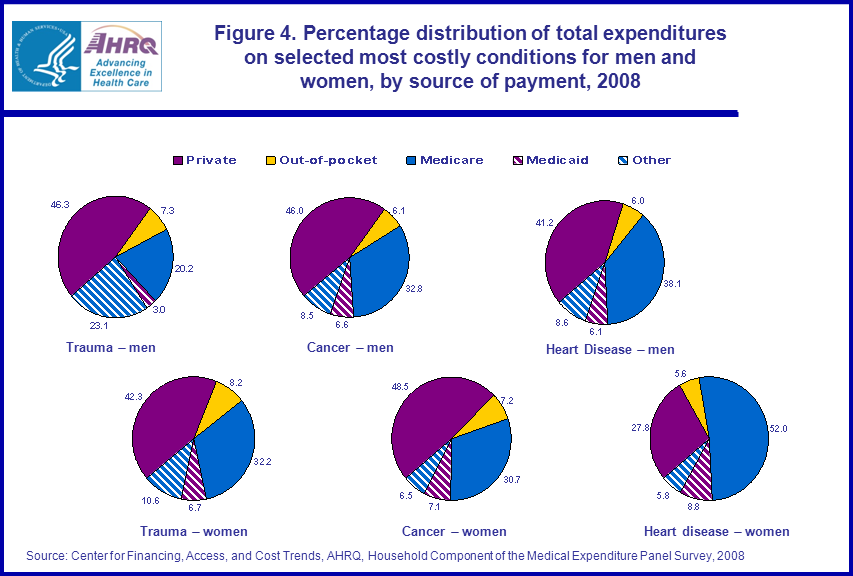
|
|
Font Size:
|
||||
|
|
|
|
||||
STATISTICAL BRIEF #331:
Top 10 Most Costly Conditions among Men and Women, 2008: Estimates for the U.S. Civilian Noninstitutionalized Adult Population, Age 18 and Older
Highlights
- In 2008, the top 10 costliest medical conditions (in a different rank order) were the same for men and women age 18 years and older--heart disease, cancer, mental disorders, trauma-related disorders, osteoarthritis, asthma, hypertension, diabetes, back problems, and hyperlipidemia.
- The highest expense was reported to treat heart disease in both men ($47.3 billion) and women ($43.6 billion).
- For women, the highest per person mean expenditures were for the treatment of cancer ($4,484).
- For women, Medicare paid more than half of the expenditures on heart disease (52.0 percent).
Introduction
Health care expenditures for the treatment of chronic conditions have been on the rise in the United States. Traditionally, medical expenditures have been concentrated for the treatment of certain types of highly prevalent conditions or for which treatment often entails the use of high cost services.The purpose of this Statistical Brief is to compare the pattern of medical care utilization and expenditures for men and women. The Brief uses data from the Medical Panel Expenditure Survey regarding medical expenditures associated with 10 most costly conditions for men and women, age 18 and older in 2008. These top ten most costly conditions for adults were determined by totaling and ranking the expenses by condition for all medical care provided in 2008. Only differences between estimates that are statistically significant at the 0.05 level are discussed in the text.
Findings
In 2008, the top 10 most costly conditions in terms of health care expenditures for women and men were the same, although the rank order was different. The top 2 conditions, heart disease and cancer, ranked first and second for both men and women in terms of overall expenditures. For women, mental disorders and trauma-related disorders were third and fourth followed by osteoarthritis, asthma, hypertension, diabetes, back problems, and hyperlipidemia. For men, the order from third to tenth was slightly different. Trauma-related disorders and osteoarthritis were third and fourth followed by mental disorders, diabetes, hypertension, hyperlipidemia, asthma, and back problems.The highest expenditures were for the care and treatment of heart disease among women and men at $43.6 billion and $47.3 billion, respectively. For women, the lowest expenditures among the top 10 costliest conditions were for hyperlipidemia ($18.0 billion). For men, the lowest expenditures were for back problems ($14.4 billion). The expenditures for the treatment of mental disorders, asthma, and osteoarthritis were higher for women than men (figure 1).
In terms of mean expenditures per person with expenses, the mean expenditures were highest for cancer for both men as well as women ($4,873 and $4,484 respectively). For the care and treatment of heart disease, the average expenditure was $3,723 per female and $4,363 per male (figure 3).
Medicare paid for more than half of the expenditures for heart disease among women (52.0 percent) (figure 4). Private insurance paid 41.2 percent of the heart disease related expenditures for men. Almost half (48.5 percent) of the expenditures for cancer treatment among women were paid by private insurance. For expenditures among men, private insurance paid for almost half of the expenditures for trauma-related disorders (46.3 percent).
Data Source
The estimates shown in this Statistical Brief are based on data from the MEPS 2008 Full Year Consolidated Data File (HC-121), Medical Conditions File (HC-120), Office-Based Medical Provider Visits File (HC-118G), Outpatient Visits File (HC-118F), Hospital Inpatient Stays File (HC-118D), Home Health File (HC-118H), Emergency Room Visits File (HC-118E), and Prescribed Medicines File (HC-118A).Definitions
*All child birth related expenditures were excluded from the top 10 most costly conditions.Medical conditions
Condition data were collected from household respondents during each round as verbatim text and coded by professional coders using the International Classification of Diseases, Ninth Revision (ICD-9). ICD-9-CM condition codes were then aggregated into clinically meaningful categories that group similar conditions using the Clinical Classification System (CCS) software. Categories were collapsed when appropriate. The reported ICD-9-CM condition code values were mapped to the appropriate clinical classification category prior to being collapsed to 3-digit ICD-9-CM condition codes. The result is that every record which has an ICD-9-CM diagnosis code also has a clinical classification code.
Expenditures
Expenditures in MEPS are defined as payments from all sources for hospital inpatient care, ambulatory care provided in offices and hospital outpatient departments, care provided in emergency departments, paid care provided in the patient’s home (home health), and the purchase of prescribed medications. Sources include direct payments from individuals, private insurance, Medicare, Medicaid, Workers’ Compensation, and miscellaneous other sources. Payments for over-the-counter drugs are not included in MEPS total expenditures. Indirect payments not related to specific medical events, such as Medicaid Disproportionate Share and Medicare Direct Medical Education subsidies, are also excluded.
Expenditures were classified with a condition if a visit, stay, or medication purchase was cited as being related to the specific condition. Expenditures may be associated with more than one condition and are not unduplicated in the condition totals; summing over conditions would double-count some expenses. Total spending does not include amounts for other medical expenses, such as durable and nondurable supplies, medical equipment, eyeglasses, ambulance services, and dental expenses because these items could not be linked to specific conditions.
Sources of payment
- Private insurance: This category includes payments made by insurance plans covering hospital and other medical care (excluding payments from Medicare, Medicaid, and other public sources), Medigap plans, and TRICARE (Armed Forces-related coverage).
- Medicare: Medicare is a federally financed health insurance plan for the elderly, persons receiving Social Security disability payments, and persons with end-stage renal disease. Medicare Part A, which provides hospital insurance, is automatically given to those who are eligible for Social Security. Medicare Part B provides supplementary medical insurance that pays for medical expenses and can be purchased for a monthly premium. Medicare Part D, which started in 2006, covers prescription drug expenses.
- Medicaid/CHIP: This category includes payments made by the Medicaid and CHIP programs which are means-tested government programs financed jointly by federal and state funds that provide health care to those who are eligible. Medicaid is designed to provide health coverage to families and individuals who are unable to afford necessary medical care, while CHIP provides coverage to additional low income children not eligible for Medicaid. Eligibility criteria for both programs vary significantly by state.
- Out of pocket: This category includes expenses paid by the user or other family member.
- Other sources: This category includes payments from other federal sources such as Indian Health Service, military treatment facilities, and other care provided by the federal government; various state and local sources (community and neighborhood clinics, state and local health departments, and state programs other than Medicaid/CHIP); various unclassified sources (e.g., automobile, homeowner’s, or other liability insurance, and other miscellaneous or unknown sources); Medicaid/CHIP payments reported for persons who were not reported as enrolled in the Medicaid or CHIP programs at any time during the year; and private insurance payments reported for persons without any reported private health insurance coverage during the year.
About MEPS-HC
MEPS-HC is a nationally representative longitudinal survey that collects detailed information on health care utilization and expenditures, health insurance, and health status, as well as a wide variety of social, demographic, and economic characteristics for the U.S. civilian noninstitutionalized population. It is cosponsored by the Agency for Healthcare Research and Quality and the National Center for Health Statistics.References
For a detailed description of the MEPS-HC survey design, sample design, and methods used to minimize sources of non-sampling errors, see the following publications:Cohen, J. Design and Methods of the Medical Expenditure Panel Survey Household Component. MEPS Methodology Report No. 1. AHCPR Pub. No. 97-0026. Rockville, MD. Agency for Health Care Policy and Research, 1997. http://www.meps.ahrq.gov/mepsweb/data_files/publications/mr1/mr1.shtml
Cohen, S. Sample Design of the 1996 Medical Expenditure Panel Survey Household Component. MEPS Methodology Report No. 2. AHCPR Pub. No. 97-0027. Rockville, MD. Agency for Health Care Policy and Research, 1997. http://www.meps.ahrq.gov/mepsweb/data_files/publications/mr2/mr2.shtml
Cohen, S. Design Strategies and Innovations in the Medical Expenditure Panel Survey. Medical Care, July 2003: 41(7) Supplement: III-5–III-12.
Cohen, J. and Krauss, N. Spending and Service Use among People with the Fifteen Most Costly Medical Conditions, 1997. Health Affairs; 22(2):129-138, 2003.
Suggested Citation
Soni, A. Top 10 Most Costly Conditions among Men and Women, 2008: Estimates for the U.S. Civilian Noninstitutionalized Adult Population, Age 18 and Older. Statistical Brief #331. July 2011. Agency for Healthcare Research and Quality, Rockville, MD. http://www.meps.ahrq.gov/mepsweb/data_files/publications/st331/stat331.shtmlAHRQ welcomes questions and comments from readers of this publication who are interested in obtaining more information about access, cost, use, financing, and quality of health care in the United States. We also invite you to tell us how you are using this Statistical Brief and other MEPS data and tools and to share suggestions on how MEPS products might be enhanced to further meet your needs. Please e-mail us at MEPSPD@ahrq.gov or send a letter to the address below:
Steven B. Cohen, PhD, Director
Center for Financing, Access, and Cost Trends
Agency for Healthcare Research and Quality
540 Gaither Road
Rockville, MD 20850
 |
|||||||||||||||||||||||||||||||||||||||||||||||||||||||
|
|||||||||||||||||||||||||||||||||||||||||||||||||||||||
|
|
|||||||||||||||||||||||||||||||||||||||||||||||||||||||
 |
|||||||||||||||||||||||||||||||||||||||||||||||||||||||
|
|||||||||||||||||||||||||||||||||||||||||||||||||||||||
|
|
|||||||||||||||||||||||||||||||||||||||||||||||||||||||
 |
|||||||||||||||||||||||||||||||||||||||||||||||||||||||
|
|||||||||||||||||||||||||||||||||||||||||||||||||||||||
|
|
|||||||||||||||||||||||||||||||||||||||||||||||||||||||
 |
|||||||||||||||||||||||||||||||||||||||||||||||||||||||
|
|||||||||||||||||||||||||||||||||||||||||||||||||||||||
|
|
|||||||||||||||||||||||||||||||||||||||||||||||||||||||


